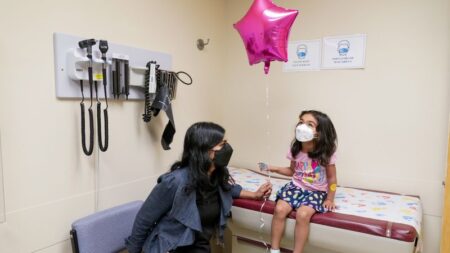The ongoing measles outbreak in the United States has become a pressing public health issue, prompting discussions at the highest levels of government. Health and Human Services Secretary Robert F. Kennedy Jr. recently attempted to downplay the severity of the outbreak during a Cabinet meeting, stating that the number of measles cases has “plateaued.” This assertion conflicts sharply with data from federal agencies that continue to report alarming increases in infections. The current situation represents the second-worst measles outbreak in the U.S. since the disease was declared eliminated in the year 2000.
The health department in Texas, which has become the epicenter of this outbreak, announced a notable increase in cases, reporting 232 new infections over the past three weeks—an increase of 42% compared to the previous three weeks. Furthermore, new outbreaks have emerged in states like Indiana and Ohio, contributing to an overall tally of at least 735 measles cases reported across 24 states this year, according to CNN. Experts estimate, however, that the true number of cases may be in the thousands. Dr. Amesh Adalja from the Johns Hopkins Center for Health Security emphasized the lack of complete situational awareness and the challenges of interpreting data in real-time when the denominator of reported cases remains unclear.
Additional concerns revolve around the underreporting of cases. The measles fatality rate typically reaches up to three deaths for every 1,000 reported cases, but three deaths, including two children in Texas and one adult in New Mexico, have already been linked to the outbreak despite official case counts being significantly lower. Dr. Nina Masters, a senior research scientist at Truveta, points out various factors contributing to this underreporting, making predictions regarding the outbreak duration and severity increasingly difficult.
Experts strongly advocate for improved data collection to inform public health responses effectively. With better data, health officials could allocate resources appropriately and better understand the underlying factors driving outbreaks. Currently, it’s clear that the majority of those contracting measles are either unvaccinated or have an unknown vaccination status. Targeted outreach efforts towards unvaccinated groups could bolster vaccination rates, which is crucial for curbing the outbreak.
The Measles-Mumps-Rubella (MMR) vaccine has proven to be highly effective when administered promptly, offering robust protection against the virus. In a past incident in 2022 involving a measles outbreak at a migrant shelter in Chicago, proactive vaccination efforts significantly reduced the number of cases. Modeling efforts indicated that without swift vaccination campaigns, cases could have reached up to 250, but the actual count was reduced to a mere 57 due to timely interventions.
While predicting the potential extent of the current outbreak, Dr. Mark S. Roberts noted that some counties in Texas have seen case numbers exceed previous predictions. For example, Gaines County, Texas, has recorded 355 cases as of April 2025, far surpassing model predictions that would generally anticipate fewer cases under similar conditions.
Public health experts are understandably frustrated by the symptoms of a failing vaccination strategy, particularly regarding children’s health. The significant decline in childhood vaccination rates, noted during the COVID-19 pandemic, has fueled this outbreak. Data from Truveta indicates that only 68.5% of children had received their first dose of the MMR vaccine by 15 months of age in 2024, a considerable drop from 77% in 2020. The ideal vaccination coverage threshold to prevent outbreaks is set at 95%.
Areas like Gaines County illustrate the challenge vividly, where nearly one in five kindergartners remained unvaccinated. The situation is echoed in Kansas, where substantial vaccination gaps exist, evident in places with shockingly low vaccination figures, such as the Sublette Unified School District, reporting a rate of just 44%.
As discussions continue regarding vaccination choices and public health recommendations, experts emphasize that eradicating measles should be a collective responsibility. Dr. Roberts encapsulated this sentiment well, urging that parents should be made aware that declining vaccination rates not only endanger their own children but also compromise the health of the wider community. Stronger messages and public health initiatives are crucial to reversing misconceptions about vaccinations, especially in the light of rising measles cases.












